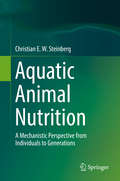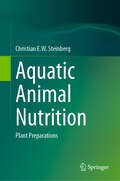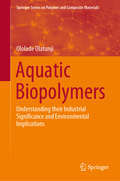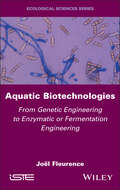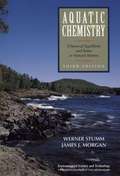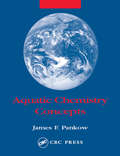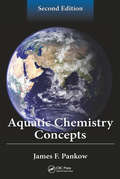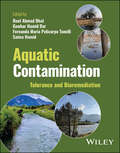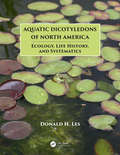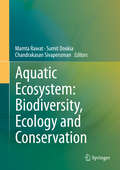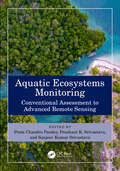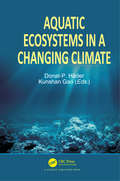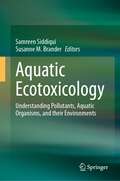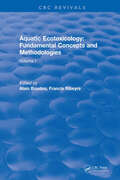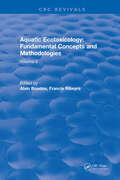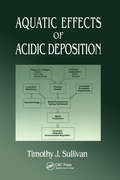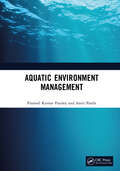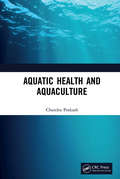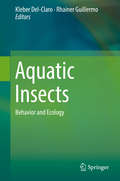- Table View
- List View
Aquatic Animal Nutrition: A Mechanistic Perspective from Individuals to Generations
by Christian E. SteinbergThis book is a unique cross fertilization of aquatic ecology and aquaculture. It shows how diets structure the digestive tract and its microbiota and, in turn, the microbiota influences life history traits of its host, including behavior. Short-term starvation can have beneficial effects on individuals themselves and succeeding generations which may acquire multiple stress resistances – a mechanism strengthening the persistence of populations. From terrestrial, but not yet from aquatic animals, it is understood that circadian the rhythmicity makes toxins or good food. On the long-term, the dietary basis impacts succeeding generations and can trigger a sympatric speciation by (epi)-genetics. This volume defines gaps in nutritional research and practice of farmed fishes and invertebrates by referring to knowledge from marine and freshwater biology. It also points out that dietary benefits and deficiencies have effects on several succeeding generations, indicating that well designed diets may have the potential to successfully improve broodstock and breeding effort.
Aquatic Animal Nutrition: Organic Macro- and Micro-Nutrients
by Christian E.W. SteinbergAs sequel to Aquatic Animal Nutrition – A Mechanistic Perspective from Individuals to Generations, the present treatise on organic macro- and micronutrients continues the unique cross fertilization of aquatic ecology/ecophysiology and aquaculture. This treatise considers proteins and their constituents, carbohydrates from mono- to polysaccharides, fatty acids from free acids to fat, and waxes. It becomes obvious that these organic nutrients are more than only simple fuel for the metabolism of animals; rather, their constituents have messenger and controlling function for the actual consuming individual and even for succeeding generations. This aspect will become particularly clear by putting the organisms under consideration back into their ecosystem with their interrelationships and interdependencies. Furthermore, micronutrients, such as vitamins and nucleotides as well as exogenous enzymes, are in the focus of this volume with known and still-to-be-discovered controlling physiological and biomolecular functions.Aquatic Animal Nutrition – Organic Macro and Micro Nutrients addresses several gaps in nutritional research and practice. One major gap is the lack of common research standards and protocols for nutritional studies so that virtually incomparable approaches have to be compared. This applies also to the studied animals, since most approaches disregard intraspecific variabilities and the existence of epimutations in farmed individuals. Furthermore, recalling the Mechanistic Perspective from Individuals to Generations, dietary benefits and deficiencies have effects on succeeding generations. In most studies, this long-term and sustainable aspect is overruled by pure short-term production aspects. By comparing nutritional behavior and success of fishes and invertebrates, Aquatic Animal Nutrition points out different metabolic pathways in these animal groups and discusses how, for instance, fishes would benefit when having some successful metabolic pathway of invertebrates. Application of novel genetic techniques will help turn this vision into reality. However, a widely missing link in the current nutritional research is epigenetics regarding transgenerational heritages of acquired morphological and physiological properties. To increase public acceptance, nutritional optimization of farmed animals based on this mechanism, rather than genetical engineering, appears promising.
Aquatic Animal Nutrition: Plant Preparations
by Christian E.W. SteinbergThis volume first covers the supplementation of aquafeeds with terrestrial plant material used in human medicine and nutrition. Mainly based on the “trial and error” approach, many supplements enhance growth, immunity and resistance to stress. However, other supplements appear to be ineffective and some have adverse effects. A robust and guiding hypothesis for supplementation is not apparent. Therefore, the book proposes the use of artificial intelligence to end the trial-and-error phase. In addition, a graded dosing is rarely used, especially in the low-dose range, so the physiological mechanisms behind the supplements are often only partially understood. This topic of aquatic animal nutrition is still in its infancy. Chapters cover medicinal plants in general, selected medicinal plants in detail, food plants, fruits, essential oils, fermentation residues, and genetically modified plants. One chapter attempts to answer the question of what mechanism may underlie ineffective or even harmful supplementation. Overall, the importance of the intestinal microflora is becoming increasingly clear and points to the imperative need to include gut microbiota in replacement studies. Based on the few epigenetic studies currently available, the importance of these processes is demonstrated. The need to integrate such approaches into future studies is emphasized. The so-called hologenomics approach is inevitable. Can adverse effects be mitigated by adding functional feed ingredients such as prebiotics or probiotics? This volume concludes with aquatic plants (macroalgae, filamentous algae, and macrophytes) as food sources for natural and farmed aquatic animals. Can aquaculture learn from natural aquatic herbivores?
Aquatic Biodiversity Conservation and Ecosystem Services (Ecological Research Monographs)
by Shin-Ichi Nakano Tetsukazu Yahara Tohru NakashizukaThis volume examines the topic of local biodiversity conservation in the Asia-Pacific region, one of the most rapidly changing areas in the world. With a focus on aquatic systems, this book offers insight on the state of local biodiversity, challenges in management and conservation of biodiversity, and newly developed methods for monitoring biodiversity. In addition, because the service provided by an ecosystem for humans is interlinked with conservation, the final part is dedicated to evaluating the socioeconomic aspect of ecosystem services, with special reference to local biodiversity. In effect, all contributions provide information that is invaluable for effective conservation and sustainable use of biodiversity. This work will interest all stakeholders in biodiversity conservation, including policy makers, NPOs, NGOs, environment-related industries, and biodiversity researchers, not only in the Asia-Pacific region, but also across the entire globe.
Aquatic Biopolymers: Understanding their Industrial Significance and Environmental Implications (Springer Series on Polymer and Composite Materials)
by Ololade OlatunjiThis book presents a comprehensive survey about the most recent developments in industrial applications, processing techniques and modifications of polymers from marine sources. It systematically introduces the reader to the biomaterials Chitin, Collagen, Alginates, Cellulose and Polyesters and links their interwoven industrial significance and environmental implications. The book elucidates the impact of industrial sourcing of the aquatic system for organic and inorganic matter on the environment and deepens the understanding of the industrial and economic significance of aquatic biopolymers. Further it addresses the question of how to balance the conservation of aquatic life and the industrial and economic interest in developing biodegradable alternatives for plastic. Thus the book will appeal to scientists in the field of chemistry, materials and polymer science as well as engineering.
Aquatic Biotechnologies: From Genetic Engineering to Enzymatic or Fermentation Engineering
by Jöel FleurenceDeveloped over several decades, the concept of aquatic biotechnology refers to aquatic organisms, be they of animal or plant origin. It involves transforming biological resources into products for human and animal consumption. The emergence of transgenic fish (such as AquAdvantage salmon) and their use as foodstuffs has reopened the societal debate on the place of genetically modified organisms in our diet. This new aquaculture based on genetic engineering is known as the "blue revolution." However, "blue" biotechnology is not limited to the production of genetically modified organisms; it also involves the use of biotechnological processes, such as enzymatic hydrolysis and fermentation, on aquatic resources. Aquatic Biotechnologies presents an overview of these biotechnological processes (genetic, enzymatic and fermentative engineering) as applied to aquatic organisms and their production methods (traditional aquaculture and aquaculture producing genetically modified organisms).
Aquatic Chemistry
by James J. Morgan Werner StummThe authoritative introduction to natural water chemistry THIRD EDITIONNow in its updated and expanded Third Edition, Aquatic Chemistry remains the classic resource on the essential concepts of natural water chemistry. Designed for both self-study and classroom use, this book builds a solid foundation in the general principles of natural water chemistry and then proceeds to a thorough treatment of more advanced topics. Key principles are illustrated with a wide range of quantitative models, examples, and problem-solving methods.Major subjects covered include:* Chemical Thermodynamics* Solid-Solution Interface and Kinetics* Trace Metals* Acids and Bases* Kinetics of Redox Processes* Dissolved Carbon Dioxide* Photochemical Processes* Atmosphere-Water Interactions* Kinetics at the Solid-Water* Metal Ions in Aqueous Solution Interface* Precipitation and Dissolution* Particle-Particle Interaction* Oxidation and Reduction* Regulation of the Chemical* Equilibria and Microbial Mediation Composition of Natural Waters
Aquatic Chemistry Concepts
by James F. PankowAquatic Chemistry Concepts fills the need for a true, easy-to-use aquatic chemistry book that goes into the details behind some of the complicated equations and principles of aquatic chemistry. It places established science into a text that allows you to learn and to solve important practical environmental problems. Environmental consultants in all fields, regulators, and libraries will consider this text an excellent reference for its clear explanation of aquatic chemistry principles.
Aquatic Chemistry Concepts, Second Edition
by James PankowAquatic Chemistry Concepts, Second Edition, is a fully revised and updated textbook that fills the need for a comprehensive treatment of aquatic chemistry and covers the many complicated equations and principles of aquatic chemistry. It presents the established science of equilibrium water chemistry using the uniquely recognizable, step-by-step Pankow format, which allows a broad and deep understanding of aquatic chemistry. The text is appropriate for a wide audience, including undergraduate and graduate students, industry professionals, consultants, and regulators. Every professional using water chemistry will want this text within close reach, and students and professionals alike will expect to find at least one copy on their library shelves. Key Features Extremely thorough, one-of-a-kind treatment of aquatic chemistry Discussions of how to carry out complex calculations regarding the chemistry of lakes, rivers, groundwater, and seawater Numerous example problems worked in complete detail Special foreword by Jerry L. Schnoor
Aquatic Contamination: Tolerance and Bioremediation
by Rouf Ahmad Bhat Gowhar Hamid Dar Fernanda Maria Policarpo Tonelli Saima HamidAquatic Contamination Authoritative resource presenting techniques and technologies to sustainably neutralize environmental contamination in aquatic plants, microorganisms, and more Two thirds of the Earth is covered with aquatic habitats that play a key role in stabilizing the global environment and providing a wide variety of services to increasing human needs. Nevertheless, anthropogenic activities are rapidly destroying the quality of both fresh and marine waters globally, due to excessive use of chemicals, fertilizers and pollution from suburban and industrial areas eventually making their way into the aquatic world. Aquatic Contamination: Tolerance and Bioremediation presents the broader spectrum of biological applicability of microbes with better understanding of cellular mechanisms for remediation of aquatic contaminants. The book also focuses on practices involved in molecular and genetic approaches, necessary to achieve targets of bioremediation and phytoremediation to solve global water contamination problems. Such approaches pave the way for the utilization of biological assets to design new, efficient, and environmentally sound remediation strategies by inculcating genomic techniques at cellular and molecular levels with model assessment. Aquatic Contamination provides a comprehensive background for readers interested in all perspectives of the contamination of aquatic environs. It covers various research aspects which are being carried out globally to understand simulation models in the assessment of xenobiotics, role of genomics, transgenic plants, and microbial enzymes for degradation and removal of toxic substances in aquatic environs. Key features include: Extensive coverage of interactions between plants, metals and microbes including the influence of biotic and abiotic factors Comprehensive discussion of the details of molecular mechanisms from assimilation to detoxification levels Exploration of the enzymatic approaches of potential plants acting as hyper-accumulators for contaminants in aquatic environs Details of sustainable tools such as transgenic plants for the manipulation of important functional microbial genes to achieve higher certainty of bioremediation Details of advances in tools and models like micro-arrays and simulation models for the complete assessment of xenobiotic compounds from cellular to degradation hierarchies Aquatic Contamination: Tolerance and Bioremediation will be substantially helpful to environmentalists, microbiologists, biotechnologists and scientists, providing essential information on various modern technologies for the remediation of contaminants in aquatic ecosystems.
Aquatic Dicotyledons of North America: Ecology, Life History, and Systematics
by Donald H. LesAquatic Dicotyledons of North America: Ecology, Life History, and Systematics brings together a wealth of information on the natural history, ecology, and systematics of North American aquatic plants. Most books on aquatic plants have a taxonomic focus and are intended primarily for identification. Instead, this book provides a comprehensive overview of the biology of major aquatic species by compiling information from numerous sources that lie scattered among the primary literature, herbarium databases, and other reference materials. Included dicotyledon species are those having an obligate (OBL) wetland status, a designation used in the USACE National Wetland Plant List. Recent phylogenetic analyses are incorporated and rationale is provided for interpreting this information with respect to species relationships. This diverse assemblage of information will be useful to a wide range of interests including academic researchers, wildlife managers, students, and virtually anyone interested in the natural history of aquatic and wetland plants. Although focusing specifically on North America, the cosmopolitan distribution of many aquatic plants should make this an attractive text to people working virtually anywhere outside of the region as well. This book is an essential resource for assisting with wetland delineation.
Aquatic Ecosystem: Biodiversity, Ecology And Conservation
by Mamta Rawat Sumit Dookia Chandrakasan SivaperumanThis book brings together the latest information on the rapid advances and developments in the field of aquatic ecology. India is very rich in terms of biological diversity due to its wide range of habitats and climatic conditions. It is home to as much as 7 per cent of the world's animal species, although it only accounts for about 2 per cent of the total landmass. The present work on biodiversity, ecology and conservation of aquatic resources represents original research in the field of aquatic biodiversity, wetland ecology and its applications with reference to the country's aquatic resources. There are 19 chapters, each contributed by an expert in his/her particular field and offering novel approaches to various topics in the area of aquatic ecosystems.
Aquatic Ecosystems
by Nicholas V. C. PoluninConcern about future supplies of fresh water to society, to meet the full range of human needs, now comes very high on the priority list of global societal issues. An overarching issue, which this book addresses, is whether global climate change is a dominant driver of change in the structure and function of all natural water-based ecosystems, or whether direct human population growth and accelerated consumption are playing an equal or greater role. This book divides the whole aquatic realm into 21 ecosystems, from those on land (both saline and fresh water) to those of the open and deep oceans. It draws on the understanding of leading ecologists to summarize the state and likely condition by the year 2025 of each of the ecosystems. Written for academic researchers and environmental professionals, the aim is to put the climate change debate into a broader context as a basis for conservation science and planning.
Aquatic Ecosystems Monitoring: Conventional Assessment to Advanced Remote Sensing
by Prem Chandra Pandey, Prashant K. Srivastava, and Sanjeev Kumar SrivastavaThis book collates traditional and modern applications of remote sensing in aquatic ecosystem monitoring. It covers conventional assessment methods like sampling, surveying, macroinvertebrates, and chlorophyll estimation for aquatic ecosystem health assessment. Advanced remote sensing technology provides timely spectral information for quantitative and qualitative assessment of water quality, shoreline changes, coral bleaching, and vegetation monitoring. The book covers different types of aquatic ecosystems like wetlands, rivers, lakes, saline, and the brackish lake. It also: Reviews the latest applications of remote sensing in the monitoring and assessment of aquatic ecosystems Includes traditional methods like cartography, sampling, surveying, phytoplankton assessment, river interlinking, and chlorophyll estimation Discusses the application of multi-source data and machine learning in monitoring aquatic ecosystems Discusses aquatic ecosystem management, services, threats, and sustainability Explores challenges, opportunities, and prospects of future Earth observation applications for aquatic ecosystem monitoring The book discusses space-borne, airborne, and drone geospatial data. The parts broadly cover aquatic ecosystem monitoring, vegetation management, advanced modeling practices, and challenges. It is meant for scientists, professionals, and policymakers working in environmental sciences, remote sensing, and geology.
Aquatic Ecosystems and Microbial Biofilms: Significance, Dynamics, Prevention and Control
by Ram Prasad Siddhardha BusiAquatic Ecosystems and Microbial Biofilms: Significance, Dynamics, Prevention and Control provides a systematic introduction and review of state-of-the-art information on microbial biofilms in aquatic ecosystems and their control. The book is designed and developed to understand the microbial biofilms in aquatic ecosystems, their role, and the control strategies. The contents of the book are well discussed to get state-of-art knowledge on various topics such as the role of biofilms in marine ecosystems, microbial biofilms, and drinking water systems, biofilms in biofouling and biocorrosion, beneficial aspects of biofilms such as biogeochemical cycling, wastewater treatment, and in biodeterioration of organic materials. This book also provides comprehensive knowledge and in-depth scientific information on the role of biofilms and their contribution to antibiotic resistance, and also advanced technologies to understand biofilms such as metagenomics.The book offers comprehensive coverage of the most essential topics, including: Microbial biofilms in aquatic ecosystems. New horizons to understand the role of biofilms in biofouling and corrosion and their control measures. Beneficial role of aquatic biofilms such as in biogeochemical cycling,wastewater treatment, and biodeterioration of organic materials. Various strategies to collaborate interdisciplinary schemes worldwide to design and develop new methods for cleaner drinking water, and information on advanced techniques such as metagenomics to understand the diversity and functional role of aquatic biofilms. This book serves as a reference book for scientific investigators who would like to study biofilms in aquatic ecosystems, as well as researchers developing methodology in this field to study biofilm formation in aquatic ecosystems, their advantages and disadvantages, and control strategies.
Aquatic Ecosystems in a Changing Climate
by Donat-P Häder Kunshan GaoGlobal climate change affects productivity and species composition of freshwater and marine aquatic ecosystems by raising temperatures, ocean acidification, excessive solar UV and visible radiation. Effects on bacterioplankton and viruses, phytoplankton and macroalgae have farreaching consequences for primary consumers such as zooplankton, invertebrates and vertebrates, as well as on human consumption of fish, crustaceans and mollusks. It has affected the habitation of the Arctic and Antarctic oceans the most so far. Increasing pollution from terrestrial runoff, industrial, municipal and household wastes as well as marine transportation and plastic debris also affect aquatic ecosystems.
Aquatic Ecotoxicology: Understanding Pollutants, Aquatic Organisms, and their Environments
by Samreen Siddiqui Susanne M. BranderThis textbook offers a basic understanding of aquatic ecotoxicology from molecular to physiological levels for graduate and advanced undergraduate students. The book covers the guidelines and lab protocols used by international organizations for ecotoxicology studies, and discusses the challenges faced by aquatic organisms in a changing climate from an ecotoxicological perspective. Readers will learn about pollutants, contaminants and chemicals of emerging concern (CECs) in aquatic environments, their impacts on environmental and human health, and what techniques can be used to curb and control their adverse impacts. The book will be useful for students in aquatic ecotoxicology, environmental pollution and marine biochemistry.
Aquatic Ecotoxicology: Volume 1: Fundamental Concepts and Methodologies
by Alain BoudouResearch into ecotoxicology can be classified into three fundamental concerns: abiotic factors, which characterize the physicochemistry of environments; biotic factors, relating to biological structures and functions; and contamination factors, which define the modes of pollution of ecosystems. The most significant research methodologies currently being developed in aquatic ecotoxicology are presented, specifically experimental approaches in the laboratory
Aquatic Ecotoxicology: Volume 2: Fundamental Concepts and Methodologies
by Alain BoudouResearch into ecotoxicology can be classified into three fundamental concerns: abiotic factors, which characterize the physicochemistry of environments; biotic factors, relating to biological structures and functions; and contamination factors, which define the modes of pollution of ecosystems. The most significant research methodologies currently being developed in aquatic ecotoxicology are presented, specifically experimental approaches in the laboratory
Aquatic Effects of Acidic Deposition
by Timothy J SullivanThe completion of the initial phase of the U.S. National Acid Precipitation Assessment Program (NAPAP) in 1990 marked the end of the largest environmental research and assessment effort to that time. The resulting series of 27 State of Science and Technology (SOS/T) Reports and the NAPAP Integrated Assessment represent a decade of work by hundreds
Aquatic Environment Management
by Amit Pande Pramod Kumar PandeyKey features – Covers different types of aquatic ecosystems like wetlands, rivers, lakes, saline, and brackish Reviews the latest applications of remote sensing in the monitoring and assessment of aquatic ecosystems Includes traditional methods like cartography, sampling, surveying, phytoplankton assessment and chlorophyll estimation Discusses the application of artificial intelligence, machine learning, data fusion in monitoring aquatic systems Explores the prospects of future Earth Observation space missions for aquatic ecosystem monitoring
Aquatic Environmental Bioengineering: Monitoring and Remediation of Contamination
by Mohammad Yaseen Mir Rouf Ahmad Bhat Gowhar Hamid Dar Moonisa Aslam DervashAquatic Environmental Bioengineering Discover the importance of remediation efforts for aquatic ecosystems Most contamination of water bodies stem from human activity, and the pollution in our water is one of the most important environmental concerns facing future generations. The most significant of these pollutants are halogenated organic compounds, petroleum hydrocarbons, radionuclides, metal and metalloids, pharmaceutical drugs, microbial toxins, and flame retardants. With such a vast array of potential contaminants and dangerously cumulating contamination levels in fragile marine environments, reparative action is more essential than ever. Aquatic Environmental Bioengineering: Monitoring and Remediation of Contamination provides the reader with a map towards environmentally safe and economically feasible technologies to intervene in polluted aquatic ecosystems. The authors suggest a phased approach consisting of site classification and risk assessment, followed by remediation technology selection and implementation. Effective methods for surveying bodies of water are particularly emphasized, and advancements in the development of novel transgenic plants and microbial fuel cells are put forward as effective tools against environmental contamination and industrial wastewater pollution. Readers will also find: A focus on the most recent and cutting-edge research on the topic: photocatalysis, the use of genetically modified organisms, and the use of nanomaterials A simple compendium of fundamental concepts in environmental engineering of aquatic ecosystems A detailed discussion of the advancement in remote sensing and geographic information (GIS), methodologies that make it possible to conduct large-scale water remediation studies at reasonable cost The ideal resource for researchers and students of environmental science, plant biotechnology, agricultural science, environmental engineering, and plant sciences, Aquatic Environmental Bioengineering will be a crucial resource for the remediation of contaminants in our aquatic ecosystems.
Aquatic Food Quality and Safety Assesment Methods
by G. Jeyasekaran R. Jeya ShakilaThe book explains on the methods and procedures adopted for testing the quality and safety of aquatic food products. The analytical techniques available for testing the chemical constituents of aquatic food with separate chapters on the analysis of lipids, proteins, vitamins, and minerals are exhaustively given to determine their nutritional quality. The various methods for sensory, physical, biochemical and microbiological quality assessments of aquatic food are explicitly given with detailed protocols for easy adoption. Special chapters covering the chemical contaminants and permitted additives for residue monitoring are dealt, as they are important food safety requirements. This book will be very helpful for the food quality control technologists, food analysts, research scholars, and fisheries professionals as a holistic guide on a variety of testing procedures for facile adoption to meet the food safety and quality regulatory requirements. Note: T& F does not sell or distribute the Hardback in India, Pakistan, Nepal, Bhutan, Bangladesh and Sri Lanka.
Aquatic Health and Aquaculture
by Chandra PrakashThis book discusses how to use the wastewaters, liquid biowastes and soils unfit for agriculture to economically viable aquaculture practices; and putting the emphasis on, aquaculture posology, the science of quantification and administration of doses in aquatic health and aquaculture management. Broadly, aquaculture practices come across three types of problems each; in the context of water quality, and fin fish and shell fish diseases; and preventive, curative and noncurative diseases in fin fish and shell fish. Note: T&F does not sell or distribute the Hardback in India, Pakistan, Nepal, Bhutan, Bangladesh and Sri Lanka.
Aquatic Insects: Behavior and Ecology
by Kleber Del-Claro Rhainer GuillermoThis book presents a broad view of the ecology and behavior of aquatic insects, raising awareness of this conspicuous and yet little known fauna that inhabits inland waterbodies such as rivers, lakes and streams, and is particularly abundant and diverse in tropical ecosystems. The chapters address topics such as distribution, dispersal, territoriality, mating behavior, parental care and the role of sensory systems in the response to external and internal cues. In the context of ecology, it discusses aquatic insects as bio indicators that may be used to assess environmental disturbances, either in protected or urban areas, and provides insights into how genetic connectivity can support the development of novel conservation strategies. It also explores how aquatic insects can inspire solutions for various problems faced by modern society, presenting examples in the fields of material science, optics, sensorics and robotics.
